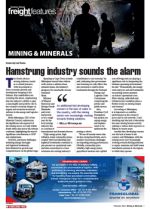Despite grappling with a myriad of challenges, the South African mining sector has showcased remarkable resilience, with recent developments indicating signs of stability and adaptability within the industry.This is according to Gwede Mantashe, minister of mineral resources and energy (DMRE), who says that over the past five years, the sector has seen some tailwinds with sizeable investments in new mining and extensions of existing mining operations.“A significant number of the new mining operations are concentrated on industrial mineral mines, diamond mines (alluvial), coal, manganese, iron, gold, platinum group metals, chrome, copper, lithium, and other precious metals,” he said, indicating the DMRE was closely monitoring the implementation of mining projects worth R400 billion, committed at various investment conferences between 2018 and 2023. These projects cut across the mining value chain and are diversified in terms of geographical location and commod it y.Mantashe said Nkwe Platinum had committed R13bn in 2021 for a new platinum mine and had to date invested approximately R640 million towards the construction of the mine, while the Mokala Manganese Mine located in the town of Hotazel in the Northern Cape, where construction began in 2019 with an investment of R1bn, was making significant strides. “The mine started producing in 2021 and to date 2.3 million tonnes of manganese has been produced and ex por ted,” he said. “Menar, through its subsidiaries, committed to invest about R7bn in coal and anthracite projects in Gauteng, Mpumalanga, and KwaZulu-Natal. Just over a week ago, the company broke ground and produced the first coal at its new Gugulethu Mine.”Mantashe said despite the challenges he remained positive about the mining sector in South Africa, particularly as activity was expected to pick up thanks to the regulatory certainty that would be introduced through the new mining licensing system. “The DMRE has procured a service provider for the design, implementation and maintenance of such a system to enhance efficiency and transparency in the application, granting and management of prospective and mining rights permits," he said indicating the implementation of the system would take place over a period of time, focusing on one province at a time.“In dealing with the licensing backlog, significant progress has been made over the past year,” said Mantashe. “Of the 2 000 applications received since the beginning of the financial year, the DMRE has granted 268 prospecting rights, 32 mining rights, 85 renewals, 184 amendments, and 190 permits. I have directed the department to work with the necessary speed to wipe out the licensing backlog within this calendar year. It would be remiss of us not to acknowledge the challenges confronted by the industry as a result of these historical backlogs. We are, however, buoyed by the unwavering support and patience from the mining industry.”He said the government was adamant about getting its business back in order and delivering an environment where mining projects could thrive.With this in mind, the DMRE has launched an exploration fund with the Industrial Development Corporation.“The establishment of this fund will catalyse some of the discoveries we have made, such as the discovery of rare earth bearing minerals, such as lithium, coltan, and phosphate in a rock formation known as pegmatine in the Northern Cape, Kwa-Zulu Natal, Mpumalanga, and Limpopo. These discoveries have brought to the fore the urgency and need for South Africa to finalise and put in place its own critical minerals strategy, which we intend to launch this year. To date, only developed countries have a strategy and definition of critical minerals. We are determined to have an African Critical Minerals Strategy,” said Mantashe.

